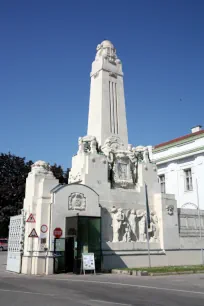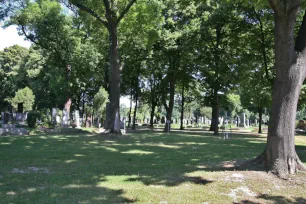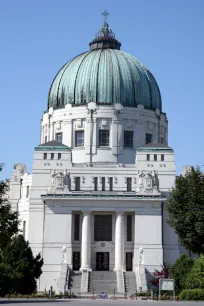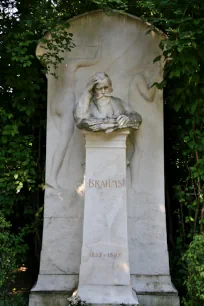Zentralfriedhof is the largest and most important cemetery in Vienna. It attracts its fair share of tourists thanks to its monumental architecture and the many famous musicians buried here, including Beethoven, Schubert and Strauss.

The Cemetery
Zentralfriedhof was created in 1874 in an area south of the inner city. The cemetery now contains the graves of more than three million Austrians. The size of the cemetery is enormous, with a total surface spanning about 2.4 square kilometers. It is divided into small numbered groups (Gruppe), making it easier to find a specific grave.



The cemetery is so large that signposts throughout the area indicate the distance to the nearest of the eleven entrance gates. The main gate at Simmeringer Hauptstraße is flanked by tall white columns decorated with statues and reliefs, a Jugendstil design by architect Max Hegele, who was also responsible for the cemetery’s main church.
Zentralfriedhof is arranged into a number of smaller cemeteries. The central area, near the imposing church, is where you’ll find the most famous of Vienna’s former citizens, including presidents, architects and musicians. Other sections contain Soviet War graves, Russian Orthodox graves, Napoleonic graves, and there are two cemeteries for Jews and one for Protestants.



Dr. Karl Lueger-Gedächtniskirche
The focal point of the cemetery is the Dr. Karl Lueger-Gedächtniskirche (Dr. Karl Lueger Memorial Church), also referred to as the Friedhofskirche zum heiligen Karl Borromäus (Cemetery Church of St. Charles Borromeo). The domed church was built between 1908 and 1911 after a design by Max Hegele, a pupil of the famous Jugendstil architect Otto Wagner.
The church is named after one of Vienna’s most popular mayors, Karl Lueger, who is buried inside the church. Several artists cooperated to decorate the interior. Of note are the murals and the sky blue painted dome.
While the Karl Lueger Church is the largest structure in the cemetery, there are several other noteworthy monuments and buildings such as the semicircular galleries decorated with impressive reliefs, a Russian orthodox chapel and a large monument honoring the victims of WWI.
Tombs of Honor
The most famous people in Vienna were buried in an area between the main entrance gate and the Karl Lueger Church in so-called Ehrengräber, Tombs of Honor.
At a circular plaza in front of the church is the Präsidentergruft, where presidents of the Austrian Republic are buried. Architects such as Adolf Loos (who designed the Loos Haus at Michaelerplatz), Theophil von Hansen (responsible for several buildings along the Ringstraße, including the Parliament Building) are buried along with other artists and architects at group 14A.
The most visited graves at Zentralfriedhof are those of Austria’s famous composers. Beethoven, Schubert, Strauss Sr. and Jr. as well as Brahms all have graves at group 32A, to the left of the main road leading to the Karl Lueger Memorial Church. At the center of the composers’ graves is a memorial to Mozart, who was not buried here, but at St. Marxer Friedhof.
Modern musicians are also buried at Zentralfriedhof, the most famous of whom is probably Falco (of “Rock me Amadeus” fame), who was buried at group 40.
- Next: Albertina
- More Sights & Attractions in Vienna

